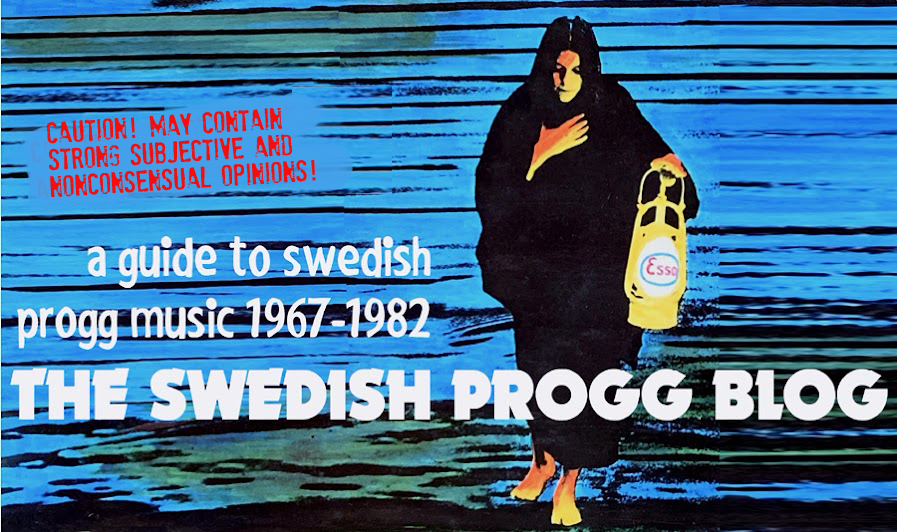Thomas Wiehe has always been
overshadowed by his more successful brother Mikael who rose to fame
with Hoola Bandoola Band before launching a much applauded solo
career. While it can be argued that Mikael Wiehe was the most
melodically talented of the two, Thomas made a couple of interesting album in the
70's. The Wiehe brothers originally played in the 60's band The Moccers, and Mikael has appeared on some of Thomas's albums.
I rummet intill (Silence, 1973)
Swedish vocals
International relevance: ***
Housed in an eye-catching cover
sporting a Channa Bankier painting, Thomas Wiehe immediately appeared
as someone well acquainted with Incredible String Band (more Mike Heron than Robin Williamson). Side two
of ”I rummet intill” is better than side one, including ”Vargen”, the spiritually inclined ”Skapelsen”, and
”Landskap”. Overall, a decent album.
Drömskugga (Silence, 1974)
as Thomas Wiehe:s Första Förband
Swedish vocals, instrumental
Swedish vocals, instrumental
International relevance: ***
”Drömskugga” is a better
album than ”I rummet intill”, much thanks to Wiehe's band on the
album, Första Förband. The electric backing provides the songs with
a greater stability even during the spacier parts and improvisational
passages of ”Raga vid det relativas nollpunkt”. The weakest
moment is the thankfully short fusion track ”Leve de vilda
strejkerna”.
Vilse i pannkakan (Silence, 1975)
with Staffan Westerberg
Swedish vocals, spoken word
Swedish vocals, spoken word
International relevance: *
Wiehe's third consists of music from
children's television series ”Vilse i pannkakan”, made by Staffan
Westerberg. Any kid that grew up in the 70's watched it but few liked
it. A strong sense of eerie unease ran through the series with
Westerberg speaking in a creepy hush and playing with dolls made of socks. He was subsequently accused of
ruining the childhood of a generation (that is MY generation!)
and what can I say... It didn't do me particularly good. In an
attempt to conquer my childhood traumas, I tried watching the series
again as an adult but that only instilled new life in my elusive fear
provoked by the fears of my younger days... It all came back to me
with fangs and glowing eyes. So the album's a hard listen for me.
Each time I hear Staffan Westerberg's voice during the spoken parts,
I throw the album to the wall and hide under the bed. Sort of.
Wiehe's songs aren't very good either, too silly even for a
children's album.
Mögel (Silence, 1975)
International relevance: **
Swedish vocals
The proper follow-up to ”Drömskugga”
and again with a full band backing on some tracks. ”Mögel” isn't
as good though, too intangible due to diffuse songwriting. A largely forgettable album.
Tårta och raketer (Silence, 1977)
International relevance: ***
Swedish vocals
A huge improvement over ”Mögel”
and hands down Thomas Wiehe's best album. The arrangements are
meticulous, substituting the rock band with baroque pop viola and
violin, adding bass saxophone, English horn, bongos and congas and
thanks to Anita Livstrand, tamboura on ”Längtan”. A beautifully
crafted album of reflective and thoroughly composed songs, dissimilar
to most other progg albums – if not all progg albums. A minor
masterpiece and a should-be classic. This largely forgotten album deserves proper discovery and love.
Två vindar (Silence, 1978)
International relevance: *
Swedish vocals
Just about any album following the
splendorous ”Tårta och raketer” would be a disappointment, but
”Två vindar” is disappointing every which way you look at it.
Dull songs, dull sound, dull playing surely make for a – you
guessed it – dull album with too many pop mainstream ambitions that
should leave most progg fans cold.
Thomas Wiehe made several albums after
”Två vindar” including one featuring Turid in 1982. He's also
continued working with children's music. He's also featured in ”Progglådan”.
from Drömskugga
Huvet upp - benen ner
Två vindar no links found
Två vindar no links found







No comments:
Post a Comment